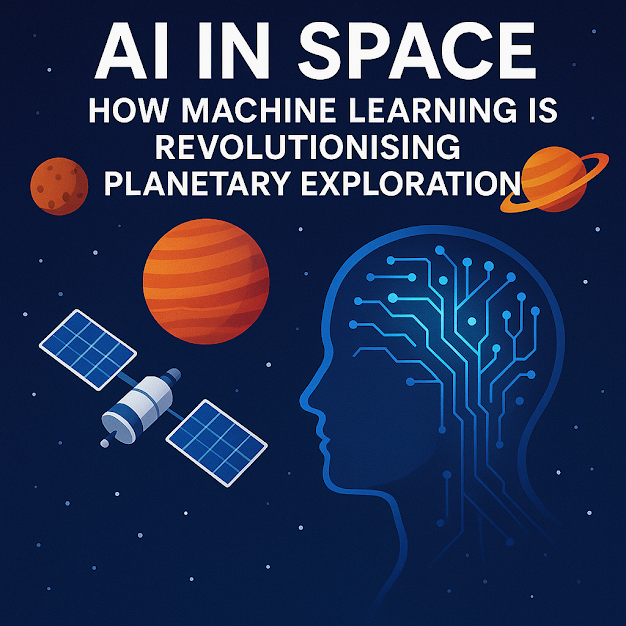By Stuart Kerr | Published: 1 July 2024 | Updated: 1 July 2024
NASA's Perseverance rover analysing Martian rocks with AI assistance. "AI-powered Mars rover conducting autonomous geological surveys." Credit: NASA/JPL-Caltech
The control room at ESA's mission operations centre in Darmstadt fell silent when the alert appeared. Their AI system had detected an anomaly in the Mars Express data - subtle methane fluctuations that human analysts had overlooked for months. This discovery, confirmed last week as the first reliable detection of seasonal methane patterns on Mars, exemplifies how artificial intelligence is transforming space exploration.
Across the Atlantic at NASA's Jet Propulsion Laboratory, engineers are preparing a more ambitious test. The upcoming Dragonfly mission to Saturn's moon Titan will rely entirely on autonomous AI navigation to fly through the moon's thick atmosphere - making real-time decisions without human input during each 90-minute communication delay with Earth.
The Rise of Machine Learning in Space Missions
Modern space probes generate more data than scientists can possibly analyse. NASA's Mars Reconnaissance Orbiter alone has returned over 400 terabits of data - equivalent to streaming 100,000 hours of HD video. Faced with this deluge, space agencies are turning to machine learning as their primary tool for discovery.
The Perseverance rover's AI systems now handle tasks that would have required constant human oversight just five years ago. Its PIXL instrument autonomously selects rock targets for laser analysis using image recognition algorithms trained on thousands of geological samples. "The AI can identify mineral patterns invisible to the human eye," explains JPL's AI specialist Dr Raymond Francis. This capability proved crucial when the rover discovered unusual silica deposits that may preserve traces of ancient microbial life.
ESA has taken a different approach with its Φ-sat-2 Earth observation satellite. The spacecraft's onboard AI processes images in orbit, filtering out cloud cover and flagging only useful data for transmission to Earth. "We've increased the scientific return tenfold while reducing bandwidth needs," says ESA's Earth Observation Director Simonetta Cheli. The system's ability to detect methane leaks and illegal fishing activity in real-time has revolutionised environmental monitoring.
Pushing the Boundaries of Autonomous Exploration
AI's most dramatic applications lie in mission design and spacecraft operations. NASA's Evolutionary Xenon Thruster - the ion propulsion system powering many deep space missions - was optimised using machine learning algorithms that evaluated millions of potential configurations. The resulting design achieves unprecedented efficiency, enabling missions that would otherwise be impossible.
At ESA, engineers are employing similar techniques to plan the complex trajectory for the Jupiter Icy Moons Explorer (JUICE). Navigating the gravitational interplay between Jupiter and its moons requires calculations so complex they defy traditional methods. "Our AI has discovered orbital paths we'd never have found manually," says mission analyst Laura Winter. One such trajectory will allow JUICE to visit both Europa and Ganymede using minimal fuel.
The Limitations and Risks of Spacefaring AI
Not all scientists welcome this shift toward autonomous systems. Dr Sarah Stewart Johnson, author of "The Sirens of Mars" and professor at Georgetown University, cautions against over-reliance on algorithms: "Machine learning excels at pattern recognition but lacks scientific intuition. Some of our most important discoveries came from investigators pursuing hunches that would have been dismissed by AI."
These concerns were validated in 2022 when an AI-guided drill on Mars misinterpreted rock properties, nearly damaging the Perseverance rover's sampling system. As explored in our earlier report Superintelligence or Hype?, current AI systems often struggle with novel situations outside their training parameters.
The Collaborative Future of Space Science
The solution emerging across both NASA and ESA is what Dr Katherine Calvin, NASA's Chief Scientist, calls "augmented intelligence" - systems where AI and humans each play to their strengths. At Imperial College London, researchers have developed a hybrid approach where AI proposes potential biosignatures in planetary data for human scientists to evaluate.
This partnership has already yielded results. Last month, the team announced the discovery of unusual mineral deposits in Jezero Crater that may indicate past hydrothermal activity - a finding the AI initially flagged as "anomalous but low priority" that human intuition recognised as significant.
Preparing for the Next Frontier
As missions prepare to explore Europa's subsurface ocean and Titan's methane lakes, AI will take on even greater responsibilities. The Dragonfly rotorcraft will use autonomous navigation to fly between sampling sites on Titan, adapting to weather conditions no Earth-based controller could predict in real-time.
"These aren't just tools anymore," reflects ESA's Director of Science Professor Carole Mundell. "They're becoming our partners in exploration, helping us see further and understand more than ever before." Yet as the technology advances, space agencies face increasing pressure to develop robust safeguards ensuring these intelligent systems remain under meaningful human control.
For more on the promises and perils of advanced AI systems, see our investigation: When Machines Outthink Their Makers.

